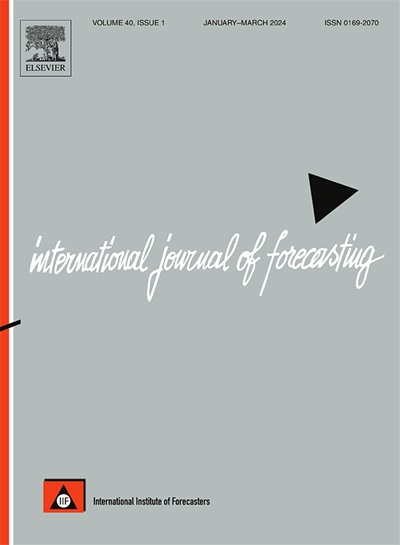指数族面板模型的自适应汇总预测
IF 7.1
2区 经济学
Q1 ECONOMICS
引用次数: 0
摘要
聚合策略扮演着与模型选择类似的重要角色,在不同的统计模型中得到了广泛的研究,以提高预测精度。然而,传统的面板数据汇总预测策略主要是在响应变量连续分布(或正态分布)的假设下开发的。本文提出了一种计算效率高的方法来构造累积风险函数,并明确地适应了主体内观测的相关结构,通过指数重权和二次重权提出了两种新的自适应聚合预测策略,并严格建立了相应的紧oracle不等式。所提出的基于指数重权的策略具有良好的Kullback-Leibler风险界适应性。此外,在二次风险下,基于二次重权的策略具有良好的自适应性能。在预先筛选的情况下,两种拟议程序的风险约束特性在温和条件下建立。分析了所提方法的标定特性。仿真研究,并以电视观众观看电视剧的二元决策序列为例,验证了我们的方法相对于现有的模型选择和聚合方法的优越性。本文章由计算机程序翻译,如有差异,请以英文原文为准。
Adaptively aggregated forecast for exponential family panel model
Aggregation strategies play an important role akin to that of model selection and have been extensively studied in different statistical models to improve forecasting accuracy. However, traditional aggregated forecast strategies for panel data are mainly developed under the assumption that response variables are continuously distributed (or normally distributed). Replacing this assumption by a more general family of distributions, i.e., exponential family distributions, this paper proposes a computationally efficient way to construct the cumulative risk function and to explicitly accommodate the correlation structure of within-subject observations, develops two novel adaptively aggregated forecasting strategies via exponential reweighting and quadratic reweighting, and rigorously establishes the corresponding tight oracle inequalities. The proposed exponential reweighting-based strategy enjoys promising Kullback–Leibler risk-bound adaptation. Moreover, under the quadratic risk, a promising adaptation property can be achieved by the quadratic reweighting-based strategy. The risk-bound properties of the two proposed procedures in the presence of pre-screening are established under mild conditions. The calibration properties of the proposed methods are also analyzed. Simulation studies, together with an example in analyzing television viewers’ binary decision sequence of watching drama episodes, verify the superiority of our methods over existing model selection and aggregation methods.
求助全文
通过发布文献求助,成功后即可免费获取论文全文。
去求助
来源期刊

International Journal of Forecasting
Multiple-
CiteScore
17.10
自引率
11.40%
发文量
189
审稿时长
77 days
期刊介绍:
The International Journal of Forecasting is a leading journal in its field that publishes high quality refereed papers. It aims to bridge the gap between theory and practice, making forecasting useful and relevant for decision and policy makers. The journal places strong emphasis on empirical studies, evaluation activities, implementation research, and improving the practice of forecasting. It welcomes various points of view and encourages debate to find solutions to field-related problems. The journal is the official publication of the International Institute of Forecasters (IIF) and is indexed in Sociological Abstracts, Journal of Economic Literature, Statistical Theory and Method Abstracts, INSPEC, Current Contents, UMI Data Courier, RePEc, Academic Journal Guide, CIS, IAOR, and Social Sciences Citation Index.
 求助内容:
求助内容: 应助结果提醒方式:
应助结果提醒方式:


